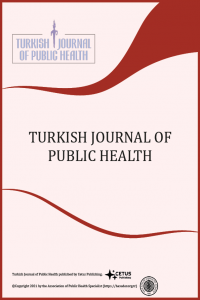Manisa ilinde kabakulak seroprevalansı ve bazı sosyal belirleyicilerle ilişkisi, 2014
Kabakulak, Aşılar, seroepidemiolojik çalışma
Seroprevalence of mumps and its association with some social determinants in Manisa Province, 2014
Mumps, vaccines, seroepidemiologic study,
___
- Reference1 Leland DS. Parainfluenza and Mumps Viruses. In: Jorgensen JH, Carroll KC, Funke Guido, Pfaller MA, Landry ML, Richter SS, Warnock DW editors. Manual of Clinical Microbiology 11th ed.Murray PR, Baron EJ. Manual of clinical microbiology. Washington, D.C.: ASM Press; 2007. p. 1487-97.
- Reference2 Roush SW, McIntyre L, Baldy LM. Manual for the surveillance of vaccine-preventable diseases. Atlanta Dep Health Hum Serv. 2008.
- Reference3 Shanley JD. The resurgence of mumps in young adults and adolescents. Cleve Clin J Med. 2007;74:42-4, 47-8.
- Reference4 Dayan GH, Rubin S. Mumps outbreaks in vaccinated populations: are available mumps vaccines effective enough to prevent outbreaks? Clin Infect Dis. 2008;47: 1458-67.
- Reference5 Greenland K, Whelan J, Fanoy E et al. Mumps outbreak among vaccinated university students associated with a large party, the Netherlands, 2010. Vaccine. 2012;30:4676-80.
- Reference6 Choi KM. Reemergence of mumps. Korean J Pediatr. 2010;53:623-8.
- Reference7 Hviid A, Rubin S, Mühlemann K. Mumps. Lancet. 2008;371:932-44.
- Reference8 Özmert EN. Dünya'da ve Türkiye'de aşılama takvimindeki gelişmeler. Çocuk Sağlığı ve Hastalık Derg. 2008;51:168-75.
- Reference9 McLean HQ, Fiebelkorn AP, Temte JL, Wallace GS, Centers for Disease Control and Prevention. Prevention of measles, rubella, congenital rubella syndrome, and mumps, 2013: summary recommendations of the Advisory Committee on Immunization Practices (ACIP). MMWR Recomm Rep. 2013;62:1-34.
- Reference10 Elias P. Occupational classification (ISCO-88): Concepts, methods, reliability, validity and cross-national comparability. OECD Publishing; 1997.
- Reference11 Solt F. Standardizing the world income inequality database. Soc Sci Q. 2009;90: 231-42.
- Reference12 Dilli D, Dallar Y, Önde U, Doğan F, Yağcı S. Ergenlerde kızamık, kızamıkçık, kabakulak ve suçiçeği seroprevalansı. Çocuk Derg. 2008;8:172-8.
- Reference13 Çelik S, Çelik N, Gültekin A, et al. Sivas İl Merkezinde Dokuz-On Altı Yaş Grubu Çocuklarda Kızamık, Kızamıkçık ve Kabakulak Seroprevalansının Araştırılması. Çocuk Dergisi 2011;11:108-13.
- Reference14 Aytaç N, Yücel A, Yaman A. Adana'da Aşılanmamış 0 - 59 Aylık Çocuklarda Kabakulak Seroprevelansı. TAF Prev Med Bull. 2010;9:29-36.
- Reference15 Vyse AJ, Gay NJ, White JM, et al. Evolution of surveillance of measles, mumps, and rubella in England and Wales: providing the platform for evidence-based vaccination policy. Epidemiol Rev. 2002;24:125-36.
- Reference16 Hamborsky J, Kroger A. Epidemiology and Prevention of Vaccine - Preventable Diseases, E-Book: The Pink Book. Public Health Foundation; 2015.
- Reference17 Hatipoğlu ÇA, Ergin F, Erteö GT, Bulut C, Berkem R, Demiröz AP. Reliability of self-reported history in predicting immunity against measles, rubella, mumps, and varicella among health care workers. Turk J Med Sci. 2010; 40: 937-41.
- Başlangıç: 2003
- Yayıncı: Halk Sağlığı Uzmanları Derneği
Manisa ilinde kabakulak seroprevalansı ve bazı sosyal belirleyicilerle ilişkisi, 2014
Yasin SAĞLAM, Özgen Alpay ÖZBEK, Duygu İŞLEK, Can Hüseyin HEKİMOĞLU, Nur DEMİRPENÇE, Mestan EMEK, Sema Alp ÇAVUŞ, Gonca ATASOYLU, İbrahim Mehmet Ali ÖKTEM, Belgin ÜNAL
Bir prospektif kohort çalışmasının temel verileri: Kapadokya kohort çalışması, Türkiye
Serhat UNAL, Sibel ASCİOGLU, Ahmet DEMİRKAZİK, İhsan ERTENLİ, Erdal ESKİOGLU, Kerim GULER, Sedat KİRAZ, Mert OZBAKKALOGLU, Birol OZER, Tufan TUKEK, Mine Durusu TANRİOVER, Eda AKYAR, Pelin CAGATAY, Yunus ERDEM
Predatory Dergi Tehlikesi Büyüyor
Bir üniversite çalışanlarının beslenme okuryazarlığı, beslenme davranışları ve ilişkili faktörler
Gülcan DEMİR ÖZDENK, Lütfiye Hilal ÖZCEBE
İnternet bağımlılığı lise öğrencilerinde kötü uyku kalitesini artırıyor
Mısır Sharkia Valiliğinin kırsal kesiminde yaşlılar arasında düşmeler
Amel Elwan MOHAMMED, Eman Elshahat ORABİ, Howida HENNERY
Acil yardım ve afet yönetimi öğrencilerinin sağlıklı yaşam biçimi davranışları
Cüneyt ÇALIŞKAN, Koray ARBERK, Sarp ÜNER
Penang’da sağlık turizminin halk sağlığı etkileri ve sonuçları
